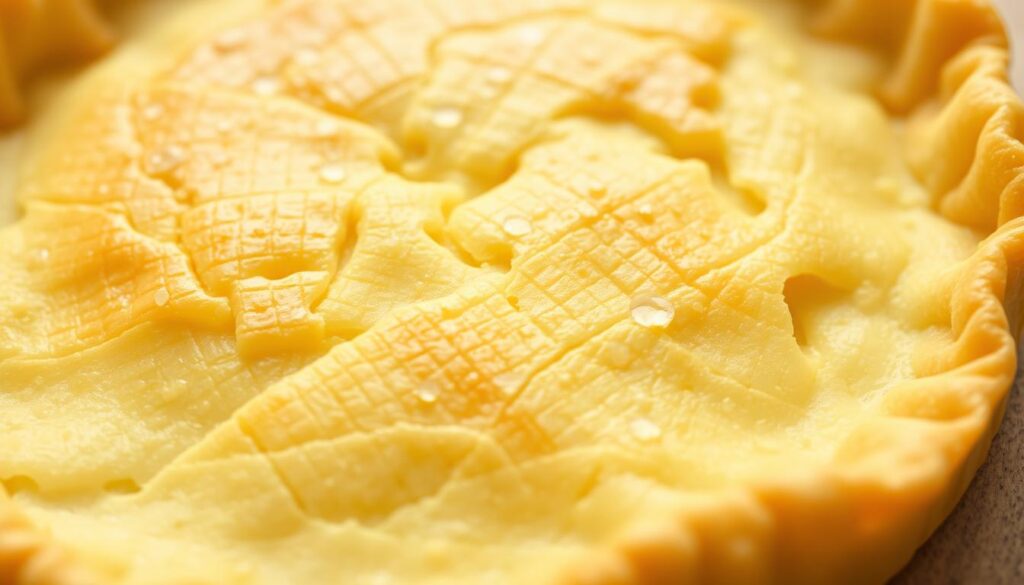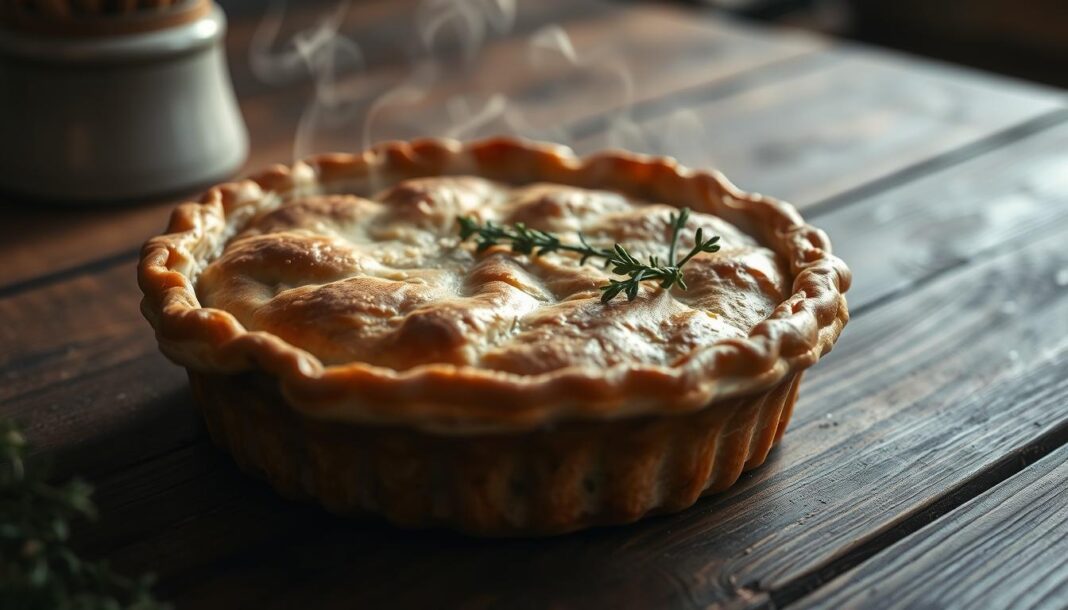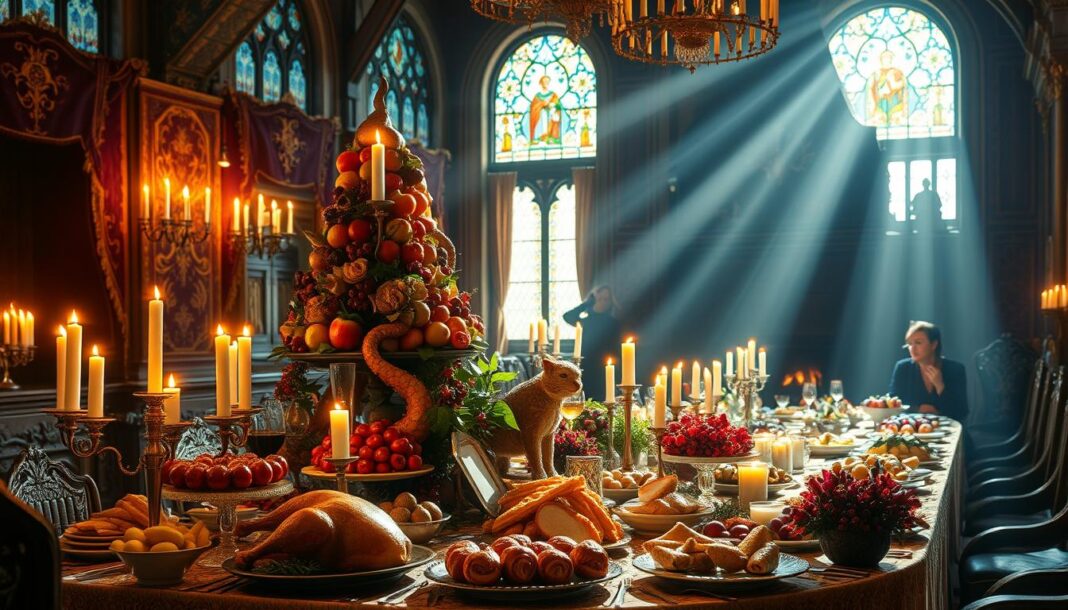We explore the rich history and cultural significance of a dish that has been a staple in culinary traditions for centuries. Pigeon pie, a delicacy enjoyed by royalty and commoners alike, represents a fascinating intersection of culinary history and cultural tradition.
Eating pigeons has been recorded since the Middle Ages, with King Juan I of Castile being a notable fan. The first recorded recipe for this savory pie was documented in a recipe book by the royal chef of Philip III in 1611.
We will take you on a journey through the historical origins of this classic dish, covering traditional ingredients and authentic preparation methods, to step-by-step instructions for creating your own version at home.
What is Pigeon Pie?
Pigeon pie, at its core, is a hearty, savory pie filled with pigeon meat and various complementary ingredients, all encased in a sturdy pastry crust. This traditional dish has been a part of culinary history, particularly in European and American cuisine.
Definition and Basic Components
The basic components of pigeon pie typically include deboned pigeon meat (often referred to as squab), along with vegetables, herbs, and spices. Sometimes, additional meat like bacon or beef is included to enhance the flavor and texture of the filling. The crust, made from traditional pastry ingredients, serves as a robust enclosure for the filling, ensuring that the flavors are locked in during baking.
Cultural Significance in American and European Cuisine
Pigeon pie holds significant cultural importance in both European and American culinary traditions. In Europe, particularly in British, French, and Spanish cuisine, it was considered both everyday fare and special occasion food. In American culinary history, pigeon pie is mentioned in early cookbooks and literature, such as in Washington Irving’s “The Legend of Sleepy Hollow,” symbolizing comfort and abundance. Despite its decline in popularity by the mid-20th century, pigeon pie remains an important chapter in the evolution of cuisine and the changing relationship between humans and their food sources.
The Rich History of Pigeon Pie
Pigeon pie, a dish once reserved for nobility, has a fascinating history that we will explore. This savory pie has its roots deeply embedded in medieval European cuisine, where it was not only a staple for the aristocracy but also a symbol of wealth and status.
Medieval Origins and Royal Connections
The history ofpigeon pietraces back to medieval Europe, where pigeons were commonly kept in dovecotes and considered a valuable food source for nobility and monasteries. The dish was particularly favored by royalty; records show it was a favorite of King Juan I of Castile. The first formalrecipeforpigeon pieappeared in a 1611 cookbook by the royal chef of Philip III, highlighting its royal connections.
Pigeon Pie in Literature: The Legend of Sleepy Hollow
Pigeon pie gained literary fame with its iconic mention in Washington Irving’s “The Legend of Sleepy Hollow” (1820). Irving vividly describes pigeons “snugly put to bed in a comfortablepie, and tucked in with a coverlet of crust.” This reference cementedpigeon pie‘s place in American literary and culinary tradition, evoking images of a luxurious and comfortingdish.
Evolution from 18th Century to Modern Times
Throughout the 18th and 19th centuries,pigeon pierecipes appeared in influential cookbooks, such as Hannah Glasse’s “The Art of Cookery Made Plain and Easy” (1747), showcasing its mainstream popularity. However, by the late 19th century, changing food preferences and the declining availability ofpigeonsfor commercialmeatled to substitutions and adaptations in traditionalrecipes. The evolution ofpigeon piereflects broader social and economic changes, including urbanization and shifting attitudes toward gamemeat.
Traditional Ingredients for an Authentic Pigeon Pie
The foundation of a genuine Pigeon Pie is its ingredients, a mix of meats, vegetables, and spices that have been used for centuries. Crafting an authentic Pigeon Pie requires understanding these traditional components and how they contribute to the dish’s overall flavor and character.
The Main Protein: Pigeon vs. Squab
Traditional Pigeon Pie primarily uses pigeon or squab as the main protein. Squab, being young pigeons, are preferred for their tender meat and milder flavor profile, making them a delicacy in culinary markets. The distinction between common pigeons and squab is significant, with squab commanding higher prices due to its desirable characteristics.
Supporting Ingredients and Flavor Profiles
Supporting ingredients such as onions, garlic, thyme, and parsley are crucial. These aromatics and herbs enhance the natural flavor of the pigeon without overpowering it, creating a balanced taste experience. Mushrooms also feature prominently, providing umami depth that complements the main protein.
Modern Substitutions: Using Chicken and Other Alternatives
For those without access to pigeon or squab, chicken breast can be a viable substitute, offering a similar texture when prepared correctly. Adjusting cooking techniques and supporting ingredients can help approximate the traditional flavor. Using finely chopped vegetables and appropriate seasoning with pepper and salt can also enhance the dish.
| Ingredient | Role in Pigeon Pie |
|---|---|
| Pigeon/Squab | Main protein, providing the core flavor and texture |
| Onions, Garlic | Aromatic vegetables that enhance flavor |
| Thyme, Parsley | Herbs that add depth and freshness |
| Mushrooms | Provide umami depth and complement the main protein |
| Bacon/Beef Steak | Additional proteins that add richness |
Making the Perfect Hot Water Pastry Crust
A well-made hot water pastry crust elevates the pigeon pie experience, offering a delightful contrast of textures. The crust’s structural integrity is crucial, as it supports the dense filling while maintaining a crisp exterior and tender interior.
Essential Ingredients for Traditional Pastry
The foundation of hot water pastry lies in its simple yet precise ingredients. We use a combination of all-purpose flour and bread flour to achieve the right balance of strength and tenderness. Salt is added to enhance flavor, while unsalted butter provides the necessary fat content. The key to this pastry is the use of boiling water, which partially cooks the flour, creating a malleable dough.
Step-by-Step Technique for Hot Water Pastry
To begin, combine the dry ingredients in a large bowl. Then, add the boiling water and fat mixture, working quickly with a wooden spoon until the mixture forms a cohesive dough. Once cool enough to handle, knead the dough by hand until it becomes pliable and smooth. This process is crucial for developing the characteristic strength and texture of hot water pastry.

Tips for Working with Hot Water Pastry
When working with hot water pastry, it’s essential to keep the dough warm throughout the shaping process. We recommend using unsalted butter to control the salt content and pressing the dough into the pan rather than rolling it out. Common mistakes to avoid include allowing the dough to cool completely before shaping and overworking it after it has cooled.
- Use unsalted butter to control salt content.
- Keep the pastry warm by leaving it near a warm stove or in a warming drawer.
- Avoid rolling out the pastry unless making the lid, as it can ruin the texture.
Complete Pigeon Pie Recipe
Now that we’ve explored the history and ingredients of pigeon pie, it’s time to dive into the complete recipe. Making a pigeon pie from scratch involves several steps, from preparing the filling to baking the pie to perfection.
Preparing the Filling
The filling is the heart of the pigeon pie, and its preparation is crucial. We start by preparing the meat, whether you’re using traditional pigeon, squab, or chicken as a modern substitute.
Meat Preparation and Seasoning
For authentic flavor, we recommend marinating the meat with herbs like thyme and parsley, and aromatics such as garlic and onion. Lightly browning the meat develops depth of flavor without overcooking it. Use 1 cup of meat, cut into bite-sized pieces, and mix with 2 tbsp of olive oil, 1 tsp of salt, and 1 tsp of pepper.
Combining Flavors and Textures
The filling combines the primary protein with supporting ingredients like mushrooms and bacon for added richness. Carefully balance the seasonings, including salt, pepper, and complementary spices. To achieve the right texture, balance the moisture from stock or wine with structure from eggs that help bind the filling during baking. Mix in 1/2 cup of mushrooms, 4 pieces of bacon, and 2 eggs.
Assembling and Baking the Pie
Assembling the pie requires careful attention to structure. Begin by pressing the hot water pastry dough into a greased 8-inch springform pan to create sturdy walls approximately 1/2-inch thick.
Forming the Pie Structure
Layer the filling ingredients thoughtfully, allowing flavors to meld while maintaining distinct textural elements throughout the pie. Roll out the top crust, transfer it to the top of the pie, and trim the edges. Pinch the bottom crust and top crust together to seal the pie.
Baking Times and Temperatures
Preheat the oven to 400°F (204°C). Bake the pie for about 45 to 50 minutes, or until it’s golden brown and the filling is bubbly. To prevent over-browning, you may need to reduce the oven temperature during baking.
Serving Suggestions
Traditional serving suggestions include allowing the pie to rest for at least an hour before removing it from the springform pan. Serve either warm or at room temperature with complementary sides. The finished pie should display a golden brown crust with visible layers of filling when sliced, offering a beautiful presentation that honors the dish’s historical significance.
By following this recipe, you’ll create a pigeon pie that’s not only delicious but also visually appealing. Enjoy the process of making this traditional dish, and don’t hesitate to experiment with modern twists and ingredients.
Modern Variations and International Influences
Pigeon pie has undergone significant transformations, reflecting both practical adaptations and creative culinary evolution. The traditional recipe has been reimagined across multiple continents and culinary traditions, resulting in distinctive regional specialties.
The Moroccan b’stilla is a notable example, combining pigeon or chicken with almonds, eggs, and a sweet-savory profile featuring cinnamon and sugar. This dish showcases the adaptability of the pigeon pie concept to local ingredients and preferences.
Contemporary chefs have reimagined pigeon pie with modern presentation styles and innovative ingredient pairings, while maintaining connections to traditional techniques. For home cooks, we provide guidelines for creating your own variations using the basic hot water pastry technique and filling principles, incorporating personal preferences and locally available ingredients.
The enduring appeal of pigeon pie across cultures demonstrates its ability to evolve while maintaining its essential character and historical significance. As we continue to experiment with new recipes and ingredients, the legacy of this traditional dish remains a vital part of our culinary heritage.


